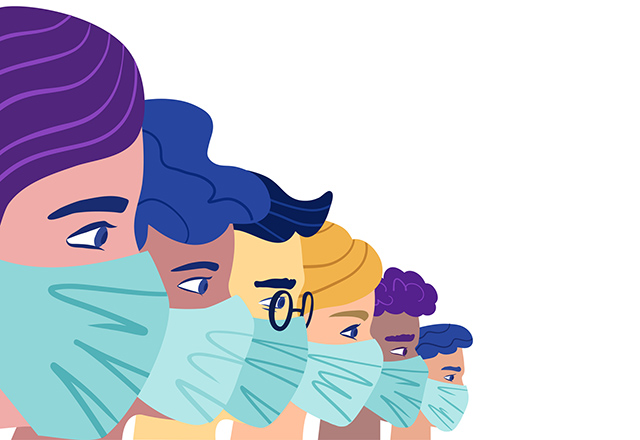For the last four months, I was quarantining at home with family, seldom leaving the house save for essential trips. My daily routine was pretty ordinary, the occasional streak of online classes interrupted by bouts of a renewed passion for quarantine baking. Often, my family and I would take walks around the neighborhood, watch a thunderstorm from the porch or binge movies. Life had become almost painfully predictable, but there was also a comfort in that. I lived in a bubble at home, but it was a bubble filled with love and laughter.
When news came out that we were returning to our clinical rotations, I felt my bubble pop. As a third-year medical student, my first rotation ever would have begun in March. I had felt all right then, ready to face a new step in my education, but now, after four months at home, I was convinced I had forgotten everything from the first two years of medical school. On top of that, I knew it would be so painful to leave my family almost 1,000 miles behind.
The quiet was the first thing I noticed when I returned to my small apartment in Baltimore. There were no sounds of pots clattering in the kitchen, no children’s shows blaring in the background. I unzipped my cat from his carrier, and he seemed to understand, letting out a sad “meow.” Or maybe he was just hungry.
The hospital was different than before. It looked the same, with the same sunlit hallways, the same sterile floors. Walking through the hospital, you might not notice anything had changed. That is, until you realized you were walking alone. In these COVID-19 times, restrictions have been placed on who can enter the hospital. Stickers dictating a 6-foot distance between people cover the floors. I still see employees moving through the halls, following routine in a new normal. It’s a strange feeling to be connected with more people than during quarantine at home, but to feel the same sense of careful isolation.
On my floor, we all sit 6 feet apart. Surprisingly, things feel fairly normal. I am still learning, and I still feel supported by kind attendings, residents and subinterns. They often check in to see if I’m doing OK. In this strange, new isolated world, I feel most supported by them. Meetings are often over Zoom, and that’s when you can see warm smiles freed from their face masks. My attending exclaims, “It’s so good to see all your faces!”
I thought I would be nervous interviewing my first patient, but I felt oddly safe behind my face mask, face shield and glasses, and with 6 feet between us. No one could see my confusion, surprise or uncertainty. No one could see me open and close my mouth as I struggled to find the right words. The silences could pass as thoughtful pauses. I could be allowing the patient time to reflect. There is safety in this newfound anonymity.
This ambiguity goes both ways, however. With the masks, you can only really see what is strong enough to reach someone’s eyes, but are those eyes squinting from a smile or contempt? Is that an eye roll, or is it just uncomfortably hot under the mask? It’s hard to read someone’s face when most of it is covered. It’s hard to make a connection. There are no more smiles, no comforting taps on the shoulder when someone breaks down. I find myself using exaggerated expressions with patients, hoping the expressions somehow reach my eyes. I hope they feel less lonely, but the honest truth is, I’m not sure.
“I can’t watch the news anymore without crying,” she says, looking to the ceiling in an attempt to dry her eyes. “People are dying without their loved ones.” This comes from one of our patients, who hasn’t seen her husband in weeks. With COVID-19, there are new, painful limitations. Family meetings are often done over Zoom, and visitations are limited to extreme situations. I am lucky to be able to leave the hospital every day and return to my home. The new normal is difficult for care providers, but it doesn’t hold a candle to how it is for our patients. Their safety, and our safety, come first. But each comes with a price, and that price is isolation.
Many of our patients are lonely and homesick. They’re without their greatest sources of support at their time of greatest need. As a student, I know I won’t be the one to solve anyone’s medical problem. I wasn’t sure what my role would look like in this strange COVID-19 world. After a week in the hospital, one of our most important goals as medical students has become clear — in this new, isolated normal, we have to find different ways in which we can connect and be there for our patients.
What does that look like? To give you the classic med student answer, I’m not sure, but I’ll find out for you.
Related content
- In the News: Johns Hopkins Resident Shares Experience During Pandemic with CNN
- Winning the Fulbright During COVID-19
- International Students Face an Extra Hurdle during COVID-19
Want to read more from the Johns Hopkins School of Medicine? Subscribe to the Biomedical Odyssey blog and receive new posts directly in your inbox.

This is fantastic writing, such a distillation of the upheaval visited upon all of us during COVID-19 times, with a meaningful patient focus. Kudos!
Pingback: Ten Anchors for Med24 – Biomedical Odyssey
Nice work really captured the experience of coming back to school after such a strange time
Pingback: Divergence in Coronavirus Opinions – Biomedical Odyssey
Comments are closed.